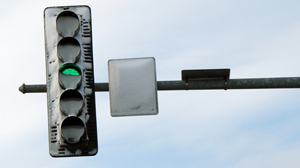Stopsicles
Red means stop. Green means go. This rule of thumb is something we learn at a young age and it helps us throughout life. After all, that rule, basically, is the law of traffic lights.
And traffic lights are pretty important. They need to work whenever there is traffic on the road — otherwise, we’re likely to have cars moving at high speeds into one another. Sure, sometimes things go wrong or a light needs replacing or something, but in most of those cases, there’s a police officer on traffic duty or some other solution available. For everyday problems, the traffic lights need to simply work.
Unfortunately, in many areas, that’s been hardly the case during the winter months. The reason: a mix of snow and environmental conscientousness.
The snow part is easy enough to understand. The skies drop inch after inch of the stuff and the winds blow it around in every direction. Get enough snow and, ultimately, the snow sticks to the traffic lights. If temperatures remain cold, the snow stays on the light, obscuring the signal from drivers, effectively rendering the traffic light worthless — that is, unless an artificial heat source melts the snow away. For much of the traffic light’s history, that heat source was always present: the light bulbs themselves emitted enough heat to warm the immediate area, turning the snow into harmless, drip-away water.
But in general, the heat emitted by light bulbs is considered wasted energy. (The point of most light bulbs is to radiate light, not heat, after all.) In recent years, science has greatly improved on the energy efficiency of the lightbulb, and we’ve moved away from the burn-your-fingers-hot incandescent bulb to the very cool LED variety. That’s great if you’re hoping to save some money long-term on your electric bill (and if you’re hoping to be more eco-friendly), but it’s not so great if you’re a commuter in a snowy area.
In those cases, a move to LED bulbs in traffic lights meant results like this:

That picture comes from the Oswego, Illinois police department via a 2010 ABC News report. The problem: the LED lights Oswego installed weren’t emitting enough heat to melt the snow, rendering the traffic signals worthless. This wasn’t just a problem in Oswego, either — it was a widespread issue affecting snowy municipalities everywhere. If you were using LED bulbs, you were driving blind. As Engadget explained in 2009, “perhaps in an homage to bad engineering everywhere, [ . . .] the inefficiency of incandescent light bulbs was previously relied upon to keep traffic signals unimpeded.” And this was no laughing matter: “the new LEDs do not achieve the same effect, which has resulted in a few accidents and even a death being blamed on obstructed traffic lights.”
A switch back to incandescents, though, wasn’t really an option. In many other respects, LEDs are a safer alternative: they last longer, don’t burn out suddenly, and can been seen from further way. Plus, they save municipalities a lot of money, so other solutions are warranted. Many are trying out snow shields — the one described here, for example, is a $20-per-light solution which uses the wind to blow snow off the light. Other places, as Gizmodo notes, have tried introducing heating elements to the lights or coating the lights with a water repellant of some sort. And if those don’t work, with the money saved, there’s probably enough left over to send a road crew around town to wash the lights off and, as needed, to melt away the ice and snow with hand-held blow torches (or the equivalent).
Unfortunately, the battle against frozen-over red lights is ongoing. As recently as March of 2014, snowed-over traffic lights were blamed by authorities for a fatal car accident in Indiana.
Bonus Fact: Got a lot of snow and don’t know what to do with it? Take maple syrup. Boil it a little more. Pour it into the snow. Put it on a stick. That’s called “maple taffy” if you’re in Canada, and it’s a not-uncommon dessert there.
From the Archives: Choose one (or both): Red Light, Green Light (it’s about North Korea) or Green Light, Red Light (it’s about Syracuse, New York).
Related: Instant snow. Comes out of a jar!
